September 2012 Archives
Your collection may have just become more valuable thanks to intense media and public interest in a recent UK auction. This sort of interest and publicity helps keep numismatics alive and drives sale prices upward.
Baldwins is one of the largest and longest running numismatic dealers and auction houses in the world and trades in the heart of London. They recently conducted an auction of primarily gold sovereigns known as the Bentley Collection which included a key piece of Australian history.
Amassed by the private collector over a 34 year collecting period the Bentley Collections owner had an eye for only the rarest and highest quality pieces. A highlight and one watched by those aspiring to collect such a rarity was an Australian 1920's gold sovereign sold in part two of these prestige auctions. Minted at the first branch of the Royal Mint outside of England, the Sydney Mint, this King George V Australian sovereign is one of only 4 known examples. 3 circulation types struck with rusted dies which includes this piece and a specimen example which sold in the Quartermaster Collection of 2009 for AUD$800,000 plus commission.
This rare sovereign was purchased by leading Sydney coin dealer Robert Jaggard acting on behalf of a very keen buyer who now has a complete Australian gold sovereign collection. The hammer dropped at £650 000 plus 24% buyers premium (over AUD$1.2 million). It had previously been sold in a 2006 public auction in Australia for AUD$582,500 a then world record price for a Royal Mint sovereign. It's provenance also leads back to it's sale by Bob Jaggard in 1979 for AUD$4,250.
Don't you wish you could turn back time....
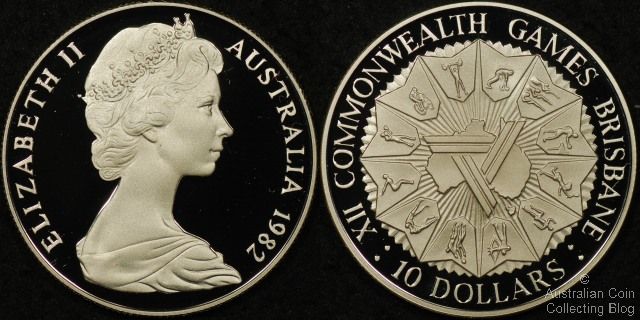
1982 10 Dollar Commonwealth Games Silver Proof
The 1988 10 Dollar Commonwealth Games coin was minted to commemorate the Brisbane Commonwealth Games in 1982. 85,142 proof coins were minted most struck by the Royal Australian Mint but due to industrial action at the time 10,048 were struck by the Melbourne based Stokes and Sons better known for medallion and button manufacturing. The difference in these issues is simply the box of issue.
The $10 coins are not a popular collecting series and as these coins are sterling silver can often be found being traded as bullion. For this reason the price fluctuates with the up and down Australian dollar and the rise and fall of the silver bullion trade. So it's worth keeping on top of the current pricing to see if you can pick up a bargain.
Todays silver price value for the 1988 $10 Commonwealth Games coin can be determined by the Australian Silver Value calculator. Or abra cadabra we've magically worked today's* rate out for you, Australian silver $10 .
*today right now, not the published date of this atricle. Internet coding at it's best! This value is updated every hour or so using the current silver price and exchange rates from Kitco.
Written by The Australian Coin Collecting Blog published in September 2012 Australasian Coin and Banknote Magazine.
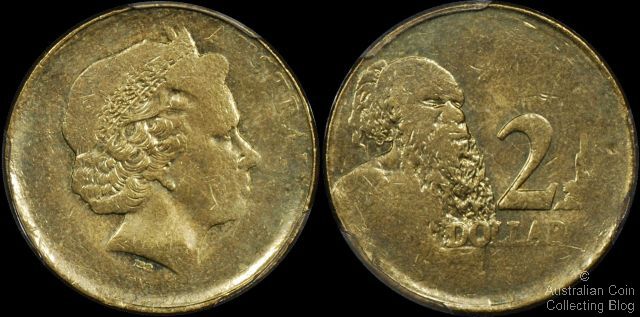
Figure 1 (left), Figure 2 (right)
The Australian $2 coin shown in Figures 1 and 2 was purchased on eBay in 2006 and is just a little different to the $2 coins we're all used to getting in our change. The design on both sides of the coin is weak and it's impossible to determine the date. The planchet is considerably underweight at 4.1g instead of the 6.6g it should be.
Firstly we think it's important to disregard post mint damage as a reason for the appearance of this coin before attempting to discover the real reasons behind it. PMD is damage that has occurred to a coin after it left the mint, in the case of this coin, the Royal Australian Mint. One type of post mint damage that could cause an underweight planchet and apparent strike weakness is exposure to acid. However, in our experience exposure to acid causes a uniform level of damage across the surface of the coin, and in this case there are areas of the coin that show full detail such as in the Queen's hair and the Aboriginal's beard. So we are not inclined to think that this coin has been exposed to and damaged by acid.
Could this coin be a counterfeit? We have seen many counterfeit $2 coins. They usually have crude depictions of the Ian Rank-Broadley obverse and the Aboriginal reverse design. To our eyes this coin does not match the counterfeits we have seen.
Another possibility is that the coin was struck through oil or grease, but this usually wouldn't result in the same uniform weakness on both sides of the coin. So we can rule that out. One last explanation could be that the coin is simply a weak strike due to low strike pressure. This could be by design as a die adjustment strike or by accident due to a press malfunction. In either case a weakly struck coin would look pretty much like the coin that we see here.
But is that all there is or could there be more to the story?
The underweight planchet is the key to the puzzle and the reason for the evident strike weakness. It could be that the underweight planchet this coin was minted on was a stray blank intended to be a coin for another country. Perhaps it mistakenly slipped into a barrel of blanks prepared overseas and was then imported to the RAM. We've seen it before more obviously with a Mob of Roos $1 struck on a Venezuelan Bi-metal planchet (Australian Coin and Banknote Magazine, April 2010). It has also happened with at least two 20c coins being struck on foreign bi-metal planchets. So, is this another example of an Australian coin being struck on a foreign planchet? This $2 coin weighs 4.1g, funnily enough the exact weight of a 10 cent Euro coin. The possibility that this $2 was struck on a Euro 10c is all the more plausible because the supplier of coin blanks to the Royal Australian Mint is the Poongsan Corporation of South Korea and they are also a major supplier of coin blanks to the global market including the Eurozone.
If this were to be an Australian $2 struck on a foreign planchet then it would be neccesary to check that it's composition is different to the aluminium bronze alloy used to make normal Australian $2 coins. This alloy comprises 92% copper, 6% aluminium and 2% nickel. It is not hugely different to the alloy that the Euro 10c is made from and to our eyes appears visually identical. The Euro 10c planchet is made from an alloy known as Nordic Gold which comprises 89% copper, 5% aluminium, 5% zinc and 1% tin.
To confirm our theory we recently sent the coin away to the Professional Coin Grading Service (PCGS) in the USA for grading and attribution. We're happy to say that they have agreed with what we'd suspected having conducted a non-destructive XRF metallurgical test on the coin which confirmed it is in fact struck on a Nordic Gold planchet. With both the composition and mass matching that of the 10 Euro Cent they had no qualms in labelling it as an Australian $2 struck on a Euro 10 cent planchet. They have slabbed and graded it as MS63 which is equivalent to Uncirculated under Australian grading standards. You can see the $2 in it's PCGS slab in Figure 3.
As far as we are aware this coin is the discovery piece for this particular type of $2 error. However, based on some news that we've heard just recently more of these interesting error coins could well be surfacing in October this year in Downies Auction #312. This suggests to us that keen eyed collectors out there should be checking any strange looking $2 coins for this type of mint error.
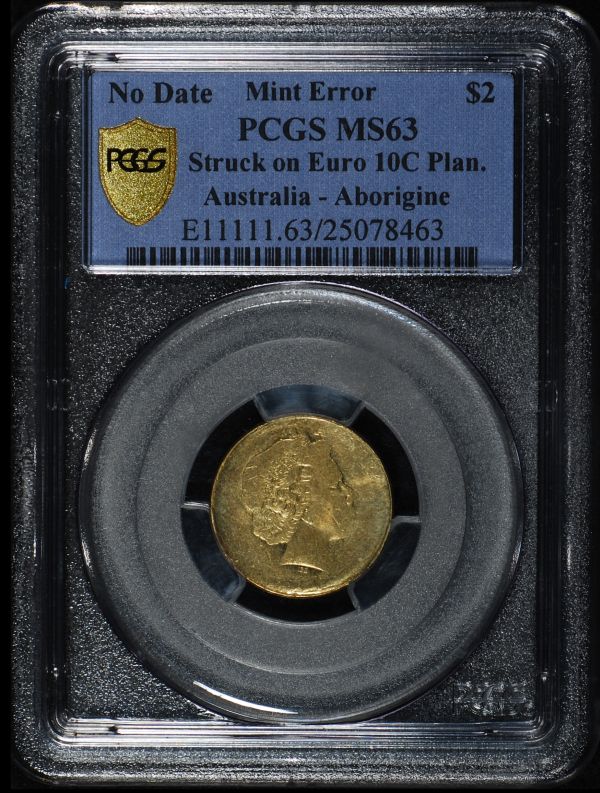
Figure 3
Update: January 2013 More Australian Two Dollar Error Coins Struck on Euro 10c Planchets
Imagine you're sitting in a public coin auction viewing and the person next to you has a notebook and pen, a calculator and a packet of Panadol. You, on the other hand have your mobile device on the table and a smile on your face. You've found the Australian Coin Collecting Blog's Mobile optimised coin calculators and can simply, quickly and easily work out the scrap value of that bullion lot in the auction. Make a note in the catalogue for when you're in the room auction or submitting your absentee bids and all the hard work is done for you. Save you calculations to pdf to view later, no problems. With so many people using their mobile internet connections to make life easier why not make use of this free and simple mobile friendly web page.

Australian Silver Calculator On The Run

Australian Silver Calculator Printed to .pdf file
The silver and gold calculators are proving very popular with collectors and dealers as a quick and easy way to calculate and total the values of both individual coins, groups of the same denominations and mixes of all sorts of coins with differing silver and gold fineness. These can be scrap bullion coin lots, junk silver lots or simple hoards of silver coins.
It's an easy way to keep track of groups of coins and calculate what their values are with the everchanging silver and gold prices. If you're an auction house and you're listing up a bullion lot of scrap Australian pre-decimal coins you might type the numbers of each coin type into the calculator, export the page to pdf or csv and print to easily show buyers what that lot contains and it's bullion value.
Eg. Coin Auctions R'Us Auction 222 September 2012
Lot 62: Australian Pre-decimal coins bullion lot threepence to crown 8.29767oz silver
If you're a collector and you have a hoard of old coins that Grandma left you and you don't know what they're worth, simply add the number of coins to the corresponding coin type in the calculator and you've got an automatic calculation of what the bullion value of that group of coins is worth. Save the calculations to pdf and print the page, take to your local bullion dealer to see what they're paying for your bullion today!

Australian Silver Calculator
There is a new place for coin chat and discussion on the internet! Come and join us at The Australian Coin Forum.
There you can discuss coins, banknotes, medals and exonumia both from Australia and across the globe. It's a place for a chat with people with the same interest as you! You register and post under a username so you have some personal security over your posted comments.
If you've been a member of ACBO, the Australian Coin and Banknote Online Forum then you will have noticed it's gone down with a thud. If you were a member there please come and visit us at our new home www.australian-coins.net
If you have an interest in collecting coins and want to chat with other collectors and experts in numismatics the come and join the new forum.
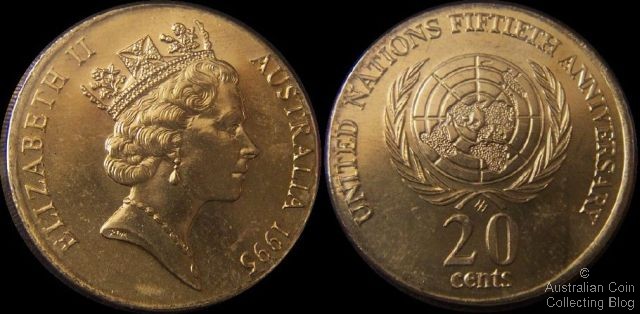
1995 United Nations 20c Struck on Wrong Planchet
This commemorative Australian 20c has been struck on a magnetic aureate bonded steel blank and not a cupro-nickel blank as it should be, hence the golden colour just like that of a dollar coin. Struck in 1995 to commemorate the 50th Anniversary of the United Nations up to three error coins of this type have been identified over the years. First outed in Australian Coin Review March 1996 an example was found in the till of a railway ticket office employee and sold to IS Wright in Sydney for a four figure sum.
A possible second example appeared in the October 2008 Status International Auction, sold for $2912.50 (incl. commision) and was discussed in an article in the Australasian Coin and Banknote Magazine in December 2008.
At the time of the original find the Royal Australian Mint was contacted and confirmed that the coin had accidently been struck on an aureate bonded steel blank intended for a Thai temple token. The RAM revealed that several different types of temple tokens had been made in 1995.
The third example and one imaged above was found in a mint roll and was advertised as being struck on an aluminium bronze planchet. Having an inkling after reading the CAB and ACR articles the new owner was pleased to make the purchase and determine it to be a magnetic planchet confirming it's origins as the same.
The weight of this 20c error is 7.6g and not the standard 11.31g. The rim of the error coin is also weakly struck because the wrong blank was smaller and intended for a 27mm coin collar and not the larger 28.52mm diameter of a regular 20c. The planchet composition ABS or aureate bonded steel is a thin lamination of copper and tin alloy over a steel core -the steel giving the coin it's magnetic properties. It is truly one of the coolest wrong planchet errors we've seen!

At the Toss of a Coin New Premises
It's been 2 and a half years since we wrote A Day at the Coin Shop and things have changed considerably for us and At the Toss of a Coins' owner Gerry McGinley. The business has just moved to bigger and better premises at Brighton, southwest of Adelaide's CBD. The new shop at 500 Brighton Road, Brighton has only been open for a week and is still being set up. Over the coming months we're sure to see window signage and some fine tuning of the shop layout. Gerry is renowned for his well-organised and well presented shop and the new premises already shows this off. At the Toss of a Coin is oriented towards sports enthusiasts selling sporting memorabilia and collectables but we're happy to say the new shop looks much more like a coin shop than the old premises! There are many cabinets full of Australian and world coins that are very easy to browse. And of course Gerry and his lovely wife are on hand to help you out. The new shop is directly opposite an ANZ bank if you run short of cash. Those of you who know Gerry will be surprised that he's moved into the 21st century and now has EFTPOS facilities in the shop!
We're quite excited about this new shop, if you're in the area it's well worth the trip. Tell Gerry you read about his new shop here on our blog!
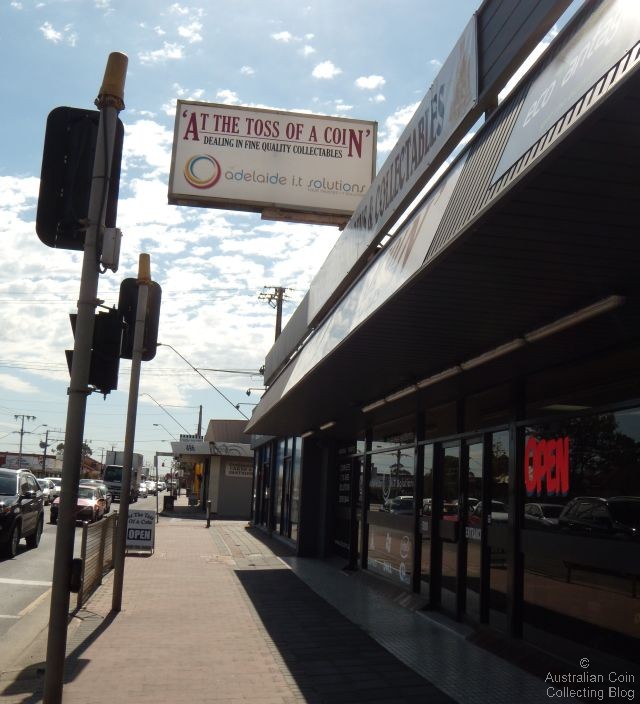
500 Brighton Rd, Brighton, Adelaide
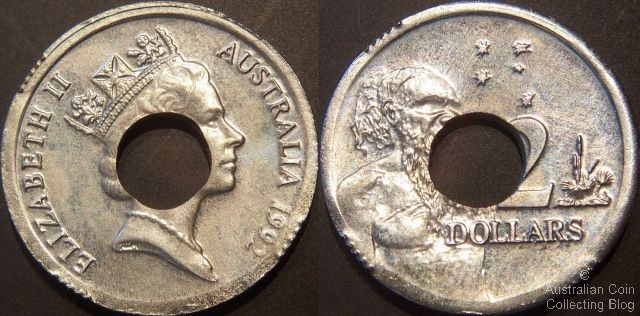
2 Dollar struck on Wrong Planchet
There's a few things we know about the above imaged coin and there's a few things we don't. It's a well struck 1992 Australian $2 coin with the Maklouf effigy of Queen Elizabeth II. It's been struck on either a foreign planchet or maybe not even a coin blank at all but a washer!
Ordinarily a $2 coin weighs 6.6g but this coin is significantly underweight at 3.8g. Now quite obviously this is primarily due to the hole in the middle of the coin! It is a metal with a ferrous base because the coin is magnetic which rules out any Australian coins of the cupro-nickel type so it's not struck on an Aussie coin planchet. This spectacular $2 error was struck on either a washer or a holed planchet intended for a coin of another country. Either way a contamination occurred in the hopper of blanks as they were fed into the press. We've spent some time searching but haven't managed to determine a country or denomination that fits the characteristics of this coin so for now it remains a mystery!
We've discussed wrong planchet errors before with an article on an Australian $1 on bi-metal planchet, a 1944s shilling on US planchet and 2c on 1c planchet. Our latest article published in the September 2012 issue of Australasian Coin and Banknote Magazine (CAB) about another $2 struck on a foreign planchet is also well worth a read.


